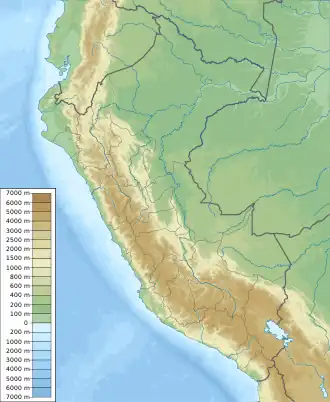1687 Peru earthquake
The 1687 Peru earthquake occurred at 11:30 UTC on 20 October. It had an estimated magnitude of 8.4–8.7 and caused severe damage to Lima, Callao and Ica. It triggered a tsunami and overall about 5,000 people died.
 | |
| Local date | 20 October 1687 |
|---|---|
| Magnitude | 8.7 Mw |
| Epicenter | 15°12′S 75°54′W[1] |
| Areas affected | Peru |
| Tsunami | Yes |
| Casualties | 5,000 |
Tectonic setting
The earthquake occurred along the boundary between the Nazca Plate and the South American Plate. The earthquake is likely to be a result of thrust faulting, caused by the subduction of the Nazca plate beneath the South American plate.
The coastal parts of Peru and Chile have a history of great megathrust earthquakes originating from this plate boundary, such as the 1960 Valdivia earthquake.
Damage
The port of Pisco was completely destroyed by the tsunami, with at least three ships being swept over the remains of the town.[2]
Characteristics
The earthquake was probably followed by another large event further to the south.[2] A magnitude of 8.7 has been estimated from tsunami runup heights and by comparison with the earthquake of 1974.[3]
The tsunami was reported in Japan where it produced runups of tens of metres.[2]
Economic impact
Chile has a history of exporting cereals to Peru dating back to 1687 when Peru was struck by both an earthquake and a stem rust epidemic.[4] Chilean soil and climatic conditions were better for cereal production than those of Peru and Chilean wheat was cheaper and of better quality than Peruvian wheat.[4][5] According to historians Villalobos et al. 1974 the 1687 events were only the detonant factor for exports to start.[4]
In the 16th and 17th century the principal wine growing area of the Americas was in the central and southern coast of Peru.[6] In Peru the largest wine-making centre was in the area of Ica and Pisco.[6] The earthquake destroyed wine cellars and mud containers used for wine storage.[7] This event marked the end of the Peruvian wine-boom.[8]
References
- IISEE. "Catalog of Damaging Earthquakes in the World (Through 2007)". Archived from the original on 6 March 2010. Retrieved 1 March 2010.
- Okal, Borrero & Synolakis 2006.
- Beck & Nishenko 1990.
- Villalobos et al. 1974.
- Collier & Sater 2004.
- Huertas Vallejos 2004.
- Lacoste 2004.
- Cortés Olivares 2005.
Sources
- Beck, Susan L; Nishenko, Stuart P (1990). "Variations in the mode of great earthquake rupture along the Central Peru Subduction Zone". Geophysical Research Letters. 17 (11): 1969–1972. Bibcode:1990GeoRL..17.1969B. doi:10.1029/gl017i011p01969.
- Collier, Simon; Sater, William F (2004), "1 - Colonial foundations, 1540–1810", A History of Chile: 1808–2002, CUP, p. 10, ISBN 978-0521534840
- Cortés Olivares, Hernán F (2005). "El origen, producción y comercio del pisco chileno, 1546–1931". Universum (in Spanish). Universidad de Talca, Chile: Instituto de Estudios Humanísticos. 20 (2): 42–81. doi:10.4067/S0718-23762005000200005.
- Huertas Vallejos, Lorenzo (2004). "Historia de la producción de vinos y piscos en el Perú". Universum (in Spanish). Universidad de Talca, Chile: Instituto de Estudios Humanísticos. 19 (2): 44–61. doi:10.4067/S0718-23762004000200004.
- Lacoste, Pablo (2004). "La vid y el vino en América del Sur: el desplazamiento de los polos vitivinícolas (siglos XVI al XX)". Universum (in Spanish). Universidad de Talca, Chile: Instituto de Estudios Humanísticos. 19 (2): 62–93. doi:10.4067/S0718-23762004000200005.
- Okal, Emile A; Borrero, José C; Synolakis, Costas E (2006). "Evaluation of Tsunami Risk from Regional Earthquakes at Pisco, Peru" (PDF). Bulletin of the Seismological Society of America. 96 (5): 1634–1648. Bibcode:2006BuSSA..96.1634O. doi:10.1785/0120050158.
- Villalobos, Sergio; Silva, Osvaldo; Silva, Fernando; Estellé, Patricio (1974), Historia de Chile (in Spanish), Chile: Editorial Universitaria, pp. 155–160